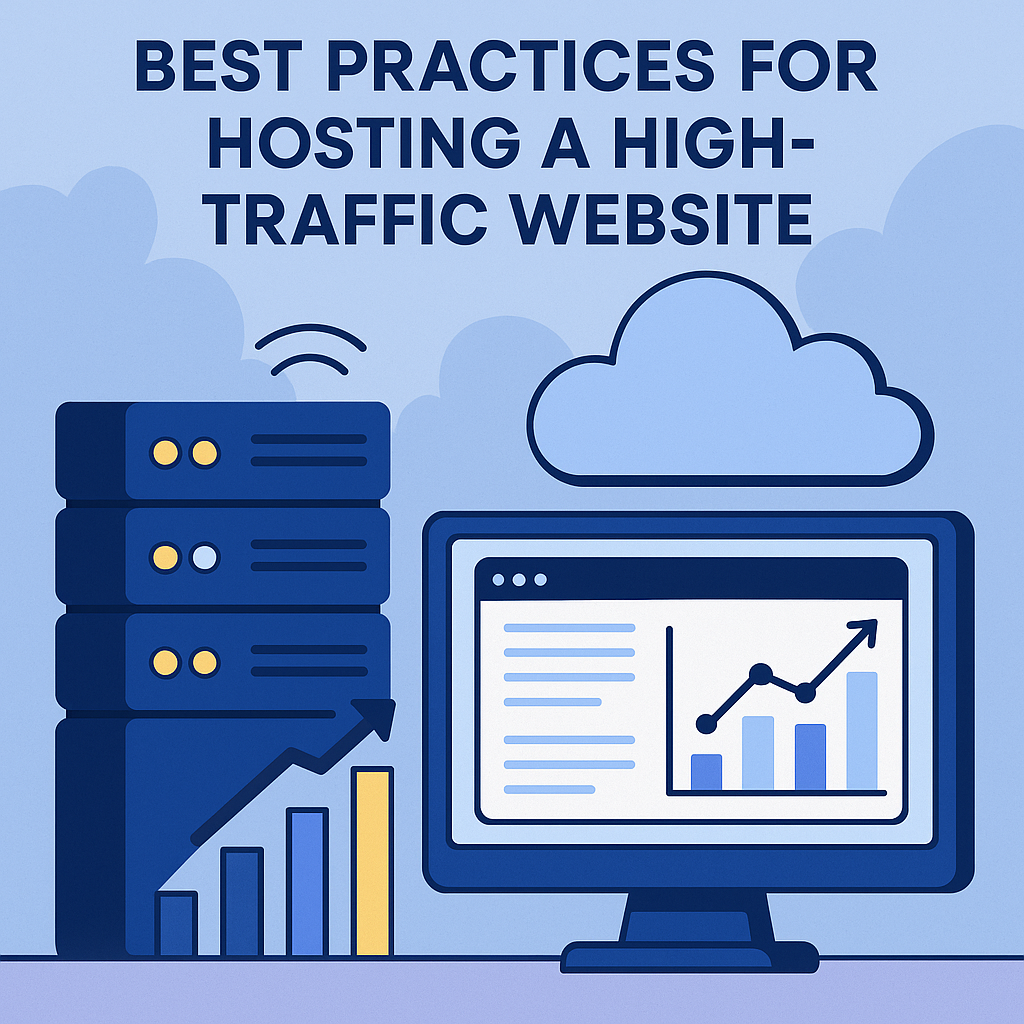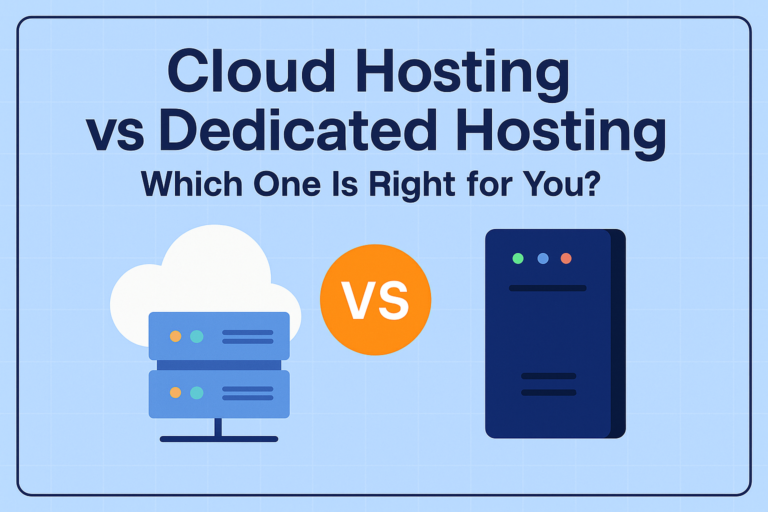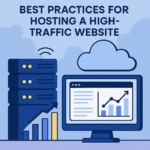Best Practices for Hosting a High-Traffic Website
Table of Contents
- Introduction
- Understanding the Challenges of High-Traffic Websites
- Choosing the Right Hosting Type
- Shared Hosting vs. VPS vs. Dedicated vs. Cloud
- Comparison Table
- Performance Optimization Strategies
- Content Delivery Network (CDN)
- Caching Mechanisms
- Load Balancing
- Scalability: Planning for Growth
- Auto-Scaling Features
- Elastic Infrastructure
- Security for High-Traffic Websites
- DDoS Protection
- SSL Certificates and Web Application Firewalls (WAF)
- Uptime and Monitoring Tool
- Real-Time Monitoring
- Incident Response
- Choosing the Right Hosting Providers
- Top Hosting Providers for High-Traffic Sites
- Pricing Table
- Developer and DevOps Best Practices
- CI/CD Pipelines
- Version Control and Deployment Tools
- Real-World Use Case Examples
- Final Thoughts: Build for Performance, Scale, and Stability
- Frequently Asked Questions (FAQ)
Introduction
In today’s digital economy, website performance isn’t just a technical concern—it’s a business imperative. Whether you’re running a booming eCommerce platform, a content-rich blog, or a SaaS startup, one thing is certain: high traffic can be a blessing or a curse depending on how well your hosting is prepared to handle it. If your site loads slowly, crash under pressure, or becomes vulnerable to security threats, you risk losing customers, revenue, and reputation. Hosting, therefore, becomes the unseen backbone of user experience, brand trust, and long-term growth.
But not all hosting is created equal. As your audience grows, so do your infrastructure needs. High-traffic websites demand more robust solutions—think scalable cloud architecture, optimized performance tools like CDNs and caching, real-time monitoring, and bulletproof security. In this guide, we’ll break down the essential best practices you need to host a high-traffic site that’s fast, secure, and scalable. From choosing the right provider to implementing smart DevOps workflows, you’ll learn how to build a hosting environment designed for growth and resilience.
Understanding the Challenges of High-Traffic Websites
Managing a high-traffic website is vastly different from running a small personal blog or a low-traffic portfolio. One of the biggest challenges is server strain—as the number of concurrent visitors grows, the demand on your server’s CPU, RAM, and bandwidth increases significantly. If your hosting setup isn’t optimized or scalable, your website might slow down or crash altogether. This is especially common with shared or under-provisioned VPS hosting, where limited resources are stretched thin. Even brief outages during peak hours can lead to massive drops in revenue, a surge in customer support issues, and damage to your online reputation.
Another critical issue is performance degradation. High-traffic sites often experience bottlenecks in database queries, file retrieval, and third-party plugin performance. Page load times increase, leading to user frustration and higher bounce rates. On mobile, this effect is amplified, as users tend to abandon sites that take longer than a few seconds to load. For businesses that rely on SEO, site speed is a ranking factor—so every millisecond counts. Poor performance can not only affect conversions but also your visibility in search engines, compounding the loss.
Security risks also escalate as your traffic grows. A popular website becomes a more attractive target for cyberattacks like DDoS (Distributed Denial-of-Service), brute force attacks, and malware injections. Hackers may attempt to exploit known vulnerabilities in themes, plugins, or backend frameworks—especially if the site isn’t regularly updated or protected. High traffic means more data is flowing through your servers, including potentially sensitive customer information. Without proper protections like SSL, Web Application Firewalls (WAF), and regular vulnerability scanning, you’re leaving the door open to significant breaches that can be costly and legally damaging.
Choosing the Right Hosting Type
Choosing the right hosting type is one of the most important decisions you’ll make for a high-traffic website. Many beginners start with shared hosting due to its low cost, but this option quickly becomes unsustainable as traffic grows. In shared hosting, your site competes for limited resources with dozens (or even hundreds) of others on the same server. This not only slows down your site under load but also increases vulnerability to performance dips and downtime if another site on the server is compromised or experiences a traffic surge. It’s simply not designed for high-traffic environments.
VPS (Virtual Private Server) hosting is a step up, giving you a dedicated portion of server resources. It’s more stable than shared hosting and allows for some customization, but scalability can still be limited, especially if you experience sudden or unpredictable spikes. Dedicated hosting, on the other hand, offers an entire server just for your website, giving you maximum control and high performance. However, it’s often more expensive, requires more technical expertise, and lacks flexibility when traffic fluctuates—if you’re not using all of the server’s resources, you’re overpaying; if you need more, you’ll need to manually upgrade or migrate.
This is where cloud hosting shines. Cloud solutions from providers like Kinsta, Cloudways, and AWS are designed to scale with your traffic. Instead of hosting your site on a single physical server, your site draws resources from a network of virtual servers. This means you can automatically scale up (or down) based on demand without experiencing downtime. Cloud hosting also offers redundancy, better disaster recovery, and access to performance-enhancing tools like global CDNs and caching integrations—all of which are critical for maintaining speed and stability under heavy load.
| Hosting Type | Best For | Scalability | Cost | Performance |
|---|---|---|---|---|
| Shared | Basic blogs | ❌ | 💲 | ❌ |
| VPS | Mid-sized projects | ⚠️ | 💲💲 | ⚠️ |
| Dedicated | Stable, high-traffic | ❌ | 💲💲💲 | ✅ |
| Cloud | Bursty/growing traffic | ✅ | 💲💲 | ✅✅ |
Performance Optimization Strategies
Performance isn’t just about speed—it’s about user experience, SEO rankings, and server stability. One of the most effective ways to boost performance is to use a Content Delivery Network (CDN). A CDN distributes copies of your website’s static content—like images, scripts, and stylesheets—across a network of servers around the world. When a visitor accesses your site, the content is delivered from the closest geographic location, dramatically reducing latency and load times. Services like Cloudflare, StackPath, and Amazon CloudFront are widely used to handle global audiences and reduce the burden on your origin server.
Caching is another powerful strategy. Browser caching stores files locally on the user’s device, minimizing repeat requests. Server-side caching, such as object and page caching using tools like Redis, Memcached, or Varnish, prevents the server from processing the same request repeatedly. For WordPress users, plugins like WP Rocket or LiteSpeed Cache can make implementation easier. These solutions can cut your load times in half and reduce database strain, especially during traffic peaks.
Finally, you should implement load balancing for environments with very high traffic or multiple application layers. A load balancer acts as a traffic director, routing incoming requests across multiple servers to prevent any single machine from getting overwhelmed. This is essential if you’re running a scalable infrastructure across regions or using a microservices architecture. Load balancing can be software-based (via Nginx or HAProxy) or managed by your cloud provider (e.g., AWS Elastic Load Balancing). It improves fault tolerance, keeps response times consistent, and is especially vital during promotions, product launches, or viral spikes in traffic.
Scalability: Planning for Growth
Scalability is one of the most overlooked aspects of hosting—until it becomes urgent. The ability to scale ensures your site performs reliably as your traffic increases. If your website goes viral, runs seasonal campaigns, or handles flash sales, your infrastructure must be prepared to respond in real time. Without scalability, a sudden surge could overwhelm your server, resulting in slowdowns or even total downtime. This is especially problematic for eCommerce stores or SaaS platforms where every second of availability translates to potential revenue or user retention.
Cloud platforms like Google Cloud, AWS, and DigitalOcean offer auto-scaling features that automatically adjust your server resources based on traffic demand. When set up properly, your site will add computing power during peak times and scale back during low-traffic hours—ensuring both cost efficiency and performance. These systems often include pre-set thresholds for CPU usage, memory load, or active connections, allowing for smart resource allocation with minimal human intervention.
Beyond resource scaling, elastic infrastructure plays a vital role in your long-term growth strategy. Horizontal scaling (adding more servers) and vertical scaling (upgrading server specs) both allow your application to grow as needed. Combined with containerized environments using tools like Docker or Kubernetes, this approach gives your website the agility to adapt on the fly—without migrations or extended downtime. Elasticity also means you can test new features, perform A/B tests, or roll out regional deployments without risking your main site’s performance.
Security for High-Traffic Websites
Security is no longer optional—especially when your site is attracting thousands or millions of visitors. A high-traffic website is an attractive target for hackers looking to exploit vulnerabilities or bring your business down. One of the most common threats is a DDoS (Distributed Denial-of-Service) attack, where an attacker floods your website with fake traffic to exhaust server resources. These attacks can take your site offline or severely degrade performance. Using services like Cloudflare, Sucuri, or Imperva helps absorb and block these attacks before they reach your origin server, keeping your site running smoothly even under pressure.
Another essential layer of protection is SSL encryption and Web Application Firewalls (WAFs). An SSL certificate ensures that data exchanged between your users and your site is encrypted—protecting sensitive information like passwords, credit card numbers, and personal details. SSL is also a Google ranking factor, so it benefits your SEO. Meanwhile, a WAF filters traffic based on rules to detect and block common attack patterns such as SQL injection, cross-site scripting (XSS), and brute-force login attempts. Solutions like the Cloudflare WAF or Sucuri’s Website Firewall are easy to configure and can drastically reduce your vulnerability footprint.
Don’t forget about internal security measures, too. Keep your CMS, plugins, themes, and server software updated at all times. Set strong, unique passwords and implement two-factor authentication (2FA) for all admin accounts. Regular backups—stored securely offsite—are also crucial so you can quickly restore your site in case of a breach or data loss. Running malware scans and auditing your code periodically adds another layer of confidence. As your traffic grows, so does the value of your data—so treat your website’s security with the same level of seriousness as you would your business’s bank account.
Uptime and Monitoring Tools
Maintaining maximum uptime is essential for any website, but it becomes mission-critical when you’re dealing with high volumes of traffic. Every minute of downtime during a peak period—such as a product launch, flash sale, or media mention—can translate into lost revenue, frustrated users, and diminished trust. That’s why it’s not enough to “hope” your site stays up. You need tools that constantly monitor your uptime and alert you the moment something goes wrong. Popular services like Pingdom, UptimeRobot, and Datadog offer real-time alerts via email, SMS, or integrations like Slack, so you can react before your users even notice an issue.
But uptime isn’t the only thing you should be tracking. Advanced monitoring tools also keep an eye on your site’s performance metrics, such as response time, page load speed, CPU and RAM usage, and even specific endpoint errors (like 404s or server errors). By analyzing these performance signals over time, you can detect subtle slowdowns or bottlenecks before they escalate into full-blown problems. Tools like New Relic, StatusCake, or even Google PageSpeed Insights can provide historical trends and detailed diagnostics that help you fine-tune your setup for optimal performance.
Equally important is having a solid incident response plan in place. This includes knowing who’s responsible when something goes down, what communication protocols to follow, and how to triage the issue quickly. Ideally, you should have rollback systems or versioned backups in place so you can restore the site to a previous state in minutes—not hours. For high-traffic websites, even a short outage can lead to negative headlines or social media backlash, so having clear internal processes, automatic failovers, and a backup hosting strategy could mean the difference between a minor blip and a business disaster.
Choosing the Right Hosting Providers
Choosing the right hosting provider is not just a technical decision—it’s a strategic one. The provider you choose becomes the foundation of your digital presence, directly affecting your site’s speed, uptime, scalability, and security. When selecting a host for a high-traffic website, it’s critical to evaluate more than just pricing or bandwidth. You need to look at real-world performance benchmarks, customer support response times, global data center coverage, and advanced features like staging environments, auto-scaling, and integrated caching. The best hosts offer infrastructure that grows with your business, not one that limits it.
For example, Kinsta is built on the Google Cloud Platform and offers highly optimized managed WordPress hosting, perfect for high-traffic blogs, media sites, or eCommerce stores. It includes built-in CDN integration, automatic scaling, and proactive uptime monitoring. Cloudways is another standout option, offering flexible cloud hosting across multiple providers like DigitalOcean, AWS, and Google Cloud. Its user-friendly dashboard makes it ideal for developers and non-technical users alike, giving you full control without the headaches of raw cloud setup. Meanwhile, WP Engine is tailored for businesses and agencies running mission-critical WordPress sites, with a focus on performance, security, and support.
For enterprise-level customization and raw infrastructure power, providers like AWS and Google Cloud remain top-tier choices. These platforms offer the ultimate in scalability and reliability, but they do require experienced DevOps resources to configure and maintain. On the other end of the spectrum, budget-conscious users can look at SiteGround as an entry point—it offers affordable shared and cloud hosting plans with decent performance and support. However, it’s important to know when to upgrade, as shared hosting will only take you so far. In high-traffic environments, a cheap host will cost you more in lost opportunities than you save on monthly fees.
| Provider | Type | Starting Price | Scalability | Notable Feature |
|---|---|---|---|---|
| Kinsta | Cloud | $35/month | ✅ | Google Cloud + CDN |
| Cloudways | Cloud (PaaS) | $14/month | ✅✅ | Managed + choice of infra |
| WP Engine | Managed WP | $20/month | ✅ | Enterprise-grade security |
| AWS | IaaS | Pay-as-you-go | ✅✅ | Massive infrastructure |
| SiteGround | Shared/Cloud | $2.99/month | ⚠️ | Affordable but entry-level |
Developer and DevOps Best Practices
Behind every fast, secure, and scalable website is a smart DevOps strategy. As your traffic increases, manual deployments and last-minute fixes become unsustainable—and risky. That’s why adopting CI/CD (Continuous Integration/Continuous Deployment) practices is essential for high-traffic environments. CI/CD pipelines automate the testing and deployment of your code, reducing the chances of human error and making rollbacks easier when something breaks. Tools like GitHub Actions, GitLab CI, and Jenkins allow you to automate these processes, ensuring that each update is stable, secure, and well-tested before it goes live.
In addition to automation, version control is a non-negotiable best practice. Using platforms like Git (via GitHub, Bitbucket, or GitLab) lets multiple developers collaborate efficiently while maintaining a clear record of code changes. This is especially important for larger teams or projects with multiple staging environments. Alongside version control, containerization with tools like Docker ensures consistent environments across development, staging, and production. It eliminates the “it works on my machine” problem and simplifies scaling through orchestration platforms like Kubernetes or Docker Swarm.
Furthermore, implementing a staging environment for testing changes before they hit your live site is critical for high-traffic websites. Many managed hosting providers now offer one-click staging environments where you can test new features, plugin updates, or security patches in a safe space. You should also adopt infrastructure as code (IaC) practices using tools like Terraform or AWS CloudFormation. These enable you to replicate your hosting infrastructure automatically and consistently, which is invaluable during migrations or when scaling to new regions. When done right, a DevOps-informed hosting approach minimizes downtime, reduces bugs, and accelerates your ability to innovate—without compromising performance or stability.
Real-World Use Case Examples
To understand the true value of proper hosting infrastructure, we can look at how some of the world’s most popular platforms manage their high-traffic environments. Take Netflix, for example—a streaming giant that serves content to over 230 million users worldwide. Netflix uses AWS extensively, not just for storage and delivery, but for its microservices architecture that powers everything from user recommendations to billing. What makes Netflix’s hosting strategy so successful is its global scale, redundant infrastructure, and use of its custom CDN, Open Connect, which ensures lightning-fast content delivery with minimal buffering. Netflix’s model shows how critical smart architecture is to support uninterrupted service during peak hours—like new show launches or global streaming surges.
Another great example is Shopify, which powers over a million eCommerce websites. During high-traffic events like Black Friday and Cyber Monday, Shopify processes billions of dollars in transactions in a single day. This is made possible through its use of Kubernetes, Google Cloud Platform, and containerized microservices. Their system scales horizontally across multiple cloud zones, automatically adjusting resources as demand increases. They also use caching, CDNs, and queuing systems to protect backend databases and APIs from overload. Shopify’s approach proves how crucial scalable infrastructure and failover systems are when performance and availability directly impact revenue.
Even major content sites like TechCrunch rely heavily on specialized hosting setups to manage spikes in traffic. Using a managed WordPress host like Kinsta or WP Engine, paired with aggressive caching and a global CDN, ensures that their articles load fast even when breaking tech news drives huge bursts of users. These platforms handle optimization, uptime monitoring, automatic backups, and even staging environments—all of which allow editorial teams to focus on publishing rather than infrastructure. For publishers, this demonstrates how managed solutions can offer both performance and simplicity when chosen wisely.
Final Thoughts: Build for Performance, Scale, and Long-Term Growth
Hosting a high-traffic website isn’t about picking the cheapest plan or hoping for the best—it’s about building a system that can grow with you. As your business, audience, or content footprint expands, your hosting infrastructure must evolve alongside it. Whether you’re a blogger preparing for viral content, an eCommerce brand ramping up for a product launch, or a SaaS company onboarding thousands of new users, your ability to deliver a fast, secure, and uninterrupted experience is what sets you apart. Hosting is no longer just a back-end decision—it’s a growth enabler.
Investing in a cloud-native, performance-optimized, and security-hardened environment allows your site to remain resilient in the face of demand. That means leveraging scalable solutions like Kinsta or Cloudways, enabling CDNs and caching layers, adopting DevOps best practices, and staying vigilant with monitoring tools. These aren’t just “nice-to-haves”—they’re the foundation of modern digital infrastructure.
Ultimately, the best hosting setup is one you don’t have to worry about. It scales when needed, protects you without disruption, and provides actionable insights when things go wrong. With the right architecture in place, you can focus on what really matters: delivering value to your users and growing your brand—confident that your site will hold strong, no matter how many people are knocking on the door.
❓ Frequently Asked Questions (FAQ)
Q1: Can I use shared hosting for a high-traffic website?
A: Shared hosting is generally not recommended for high-traffic websites. While it may be suitable for hobby blogs or early-stage projects, shared environments allocate limited CPU and memory resources across multiple users. If your site starts receiving a surge in traffic, performance can degrade rapidly—or worse, your account may get throttled or suspended. For better stability and performance, consider upgrading to cloud hosting or a dedicated environment that can handle your site’s demands more reliably.
Q2: What’s the safest and most efficient way to scale for traffic spikes?
A: The best way to scale quickly and safely is through cloud hosting with auto-scaling enabled. This feature allows your server resources (CPU, RAM, bandwidth) to grow automatically as traffic increases, without downtime or manual intervention. Combine this with a Content Delivery Network (CDN) to offload static content and prevent origin server overload. Together, these solutions ensure your website can withstand unexpected traffic spikes—such as viral campaigns or holiday sales—without slowing down.
Q3: Do I still need a CDN if most of my users are local?
A: Yes, even with a mostly local user base, a CDN can drastically improve performance and reduce strain on your origin server. By serving cached files from nearby edge locations, CDNs help minimize latency and bandwidth usage. They also add a layer of redundancy and security, acting as a buffer against minor attacks or server failures. Whether your audience is regional or global, CDNs are a cost-effective and essential component for any high-traffic website.
Q4: What are the risks of ignoring scalability and performance planning?
A: Ignoring scalability can result in disastrous outcomes. Sites that aren’t prepared for increased demand may experience slow load times, higher bounce rates, failed transactions, or complete outages. Not only does this hurt your SEO and user experience, but it can also lead to lost sales, poor reviews, and irreversible damage to your brand reputation. Planning for scalability upfront ensures your infrastructure grows with your business—not against it.
Q5: Which hosting provider should I choose if I’m not very technical?
A: If you’re looking for high performance without needing to manage technical configurations, go with a managed hosting provider. Services like Kinsta or WP Engine offer excellent support, automatic backups, performance monitoring, and security—all handled for you. These platforms are ideal for bloggers, small businesses, or teams that want premium hosting without dealing with server administration.








